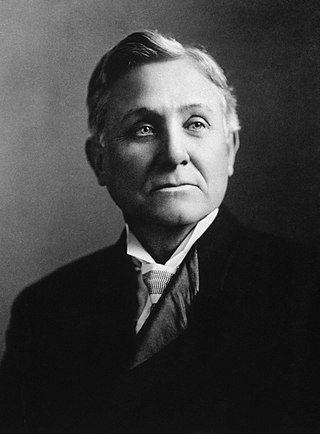
Asa Griggs Candler Sr. was an American business tycoon and politician who in 1888 purchased the Coca-Cola recipe for $238.98 from chemist John Stith Pemberton in Atlanta, Georgia. Candler founded The Coca-Cola Company in 1892 and developed it as a major company.
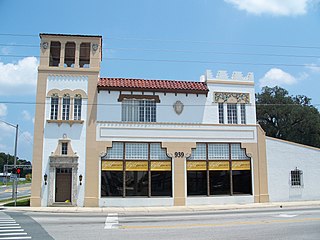
The Coca-Cola Bottling Plant is an historic building located at 939 North Magnolia Avenue in Ocala, Florida, United States. Built in 1939, it was designed by Fort Lauderdale architect Courtney Stewart in the Mission/Spanish Revival style of architecture. On May 4, 1979, it was added to the U.S. National Register of Historic Places. Now owned and operated by Gartner Group, Inc. The building is the site of Grand Pointe Ocala, the cities premier event and conference center.

Letitia "Lettie" Pate Whitehead Evans was an American businesswoman and philanthropist. She was the first woman to be on Coca-Cola's board of directors.

The Coca-Cola Bottling Plant is a historic manufacturing facility in the Evanston neighborhood of Cincinnati, Ohio. Constructed in the 1930s in high Streamline Moderne style, it no longer produces beverages, but has been named a historic site.

The Dixie Coca-Cola Bottling Company Plant, also known as Baptist Student Center, or Baptist Collegiate Ministry at Georgia State University, is a historic building at 125 Edgewood Avenue in Atlanta, Georgia. Built in 1891, it was the headquarters and bottling plant of the Dixie Coca-Cola Bottling Company, and the place where the transition from Coca-Cola as a drink served at a soda fountain to a mass-marketed bottled soft drink took place. It was declared a National Historic Landmark in 1983, and is one of the only buildings in Atlanta dating to Coca-Cola's early history. Since 1966 the building has been the Baptist Student Ministry location for Georgia State University.

The Coca-Cola Bottling Company Building, also known as the Kelly Press Building, is a historic commercial building located on Hitt Street in downtown Columbia, Missouri. It was built in 1935, and is a 1 1/2-story, Colonial Revival style brick building with a side gable roof with three dormers. It has a long one-story rear ell. Today it houses Uprise Bakery, Ragtag Cinema, Ninth Street Video, and Hitt Records.

Near Westside Historic District is a national historic district located at Elmira in Chemung County, New York. The district includes 480 principal structures over 25-30 blocks in a 77-acre (310,000 m2) district. The district is predominantly residential with only about 15 percent of the structures having commercial or mixed commercial / residential use. A full range of 19th and 20th century styles in domestic architecture is represented in the district.

Francis Palmer Smith was an architect active in Atlanta and elsewhere in the Southeastern United States. He was the director of the Georgia Tech College of Architecture from 1909–1922.

The Coca-Cola Building is a building located at 1322–1336 S. Wabash Ave. in the Near South Side community area of Chicago, Illinois, which once served as the Chicago headquarters of The Coca-Cola Company. The building was designed by Frank Abbott in the Commercial style and built from 1903 to 1904. When it opened, the building was eight stories high; two additional stories were added in 1913. The building features limestone with iron ornaments on its first two stories; a cornice with a terra cotta fretwork pattern at the top separates the second and third floors. The top of the building features a terra cotta frieze and a cornice with decorative patterns. The Coca-Cola Company operated out of the building from 1904 until 1928; the building was the company's second office outside of Atlanta. The building was the only Coca-Cola syrup manufacturing plant in the Midwest until 1915; it is now the only surviving Coca-Cola plant from before World War II outside of Atlanta.

Joseph Augustus Biedenharn was an American businessman and confectioner credited in the summer of 1894 with having first bottled the soda fountain drink, Coca-Cola, at his wholesale candy company building in Vicksburg, Mississippi. As he expanded this business, he created a model of bottling-distributor franchises and built his company through this state, as well as Louisiana and Texas.

Winchester Coca-Cola Bottling Works is a historic Coca-Cola bottling plant located at Winchester, Virginia. It was built in 1940–1941, and is a two-story, reinforced concrete Art Deco style factory faced with brick. The asymmetrical four-bay façade features large plate-glass shop windows on the first floor that allowed the bottling operation to be viewed by the passing public. It has a one-story rear addition built in 1960, and a two-story warehouse added in 1974. Also on the property is a contributing one-story, brick storage building with a garage facility constructed in 1941. The facility closed in 2006.

Charlottesville Coca-Cola Bottling Works is a historic Coca-Cola bottling plant located at Charlottesville, Virginia. It was built in 1939, and is a two-story, reinforced concrete Art Deco style factory faced with brick. It has one-story wing and a detached one-story, 42-truck brick garage supported by steel posts and wood rafters. The design features stepped white cast stone pilaster caps, rising above the coping of the parapet, top the pilasters and corner piers and large industrial style windows. In 1955 a one-story attached brick addition was made on the east side of the garage providing a bottle and crate storage warehouse. In 1981 a one-story, L-shaped warehouse built of cinder blocks was added to the plant. The building was in use as a production facility until 1973 and then as a Coca-Cola distribution center until 2010.
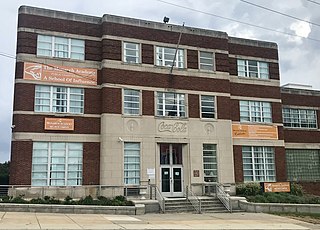
The Coca-Cola Bottling Company of Baltimore Building is a historic industrial building at 2525 Kirk Avenue in Baltimore, Maryland. The Moderne style building was built in 1939. The building includes hallmarks of the style, including rounded corners, horizontal bands of stonework, and stylized relief panels with renditions of the Coca-Cola Company logo.
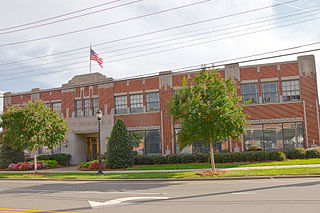
Former Charlotte Coca-Cola Bottling Company Plant is a historic Coca-Cola bottling factory building located at Charlotte, Mecklenburg County, North Carolina. It was built in 1929–1930, and is a two-story, reinforced concrete building with a red brick veneer and decorative concrete detailing and Art Deco design elements. The building has a rectangular plan measuring 110 feet by 185 feet, parapet, and Coca-Cola bottles, sculpted of precast concrete, which crown the corner pilasters.
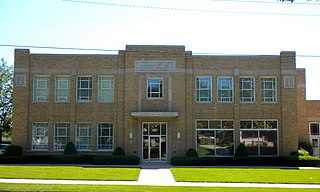
The Coca-Cola Bottling Company Building is a historic Coca-Cola bottling plant located at 616 North 24th Street in Quincy, Illinois. The building was constructed in 1940 for the J. J. Flynn Co., Coca-Cola's regional bottling company in Quincy and one of six Coca-Cola bottlers in Illinois. Local architect Martin J. Geise designed the Art Deco building, one of the few examples of Art Deco in an industrial building in Quincy. The building's design features a projecting central entrance with a high roof line, pilasters with terra cotta decorations at the front corners, and brick columns dividing the front windows; the features combine to give the building a strong vertical emphasis, an important Art Deco aesthetic. Some features of the emerging Art Moderne style are present in the building, including a stone string course, a flat overhang covering the entrance, and a flat roof.

Coca-Cola Bottling Company Plant is a historic Coca-Cola bottling plant located at Bloomington, Monroe County, Indiana. The original section was built in 1924, and is a two-story, roughly square, red brick building. A one-story section was added in a renovation of 1938–1939, along with Art Deco style design elements on the original building. It closed as a bottling plant in 1989, and subsequently converted for commercial uses.

Bloomington West Side Historic District is a national historic district located at Bloomington, Monroe County, Indiana. The district encompasses 394 contributing buildings, 2 contributing sites, and 2 contributing structures in a mixed residential, commercial, and industrial section of Bloomington. It developed between about 1850 and 1946, and includes notable examples of Queen Anne and Bungalow/American Craftsman style architecture. Located in the district are the separately listed Elias Abel House, Cantol Wax Company Building, Coca-Cola Bottling Plant, Cochran-Helton-Lindley House, Illinois Central Railroad Freight Depot, Johnson's Creamery, and Second Baptist Church. Other notable contributing resources include the Works Progress Administration constructed wading pool, White Oak Cemetery, Ninth Street Park, Bloomington Wholesale Foods Warehouse, Bloomington Garage, Curry Buick, Banneker School, Bethel African Methodist Episcopal Church, and Bloomington Frosted Foods.
The Tallulah Coca-Cola Bottling Plant in Tallulah, Louisiana, was listed on the National Register of Historic Places on January 23, 2013.
The Gadsden Coca-Cola Bottling Plant is a historic building in Gadsden, Alabama. It was built in 1929 by the Coca-Cola Company to replace a facility that had opened in 1915. In 1948–49, a two-story rear addition and one-story wing were built. The plant remained in use until 1987, when a new plant was built in the eastern part of town. The brick building is two stories, with a tile hipped roof and bracketed eaves. The original entrance features a stone surround with a keystone, but the door has since been replaced with a single-pane window. A similar entrance between the original block and the 1940s single-story addition which has scoring to imitate blocks and a Coca-Cola bottle carved into the lintel. The west elevation has a carved terra cotta sign with the Coca-Cola script logo. A separated auto garage and storage facility stands behind the main building, and is constructed of the same brick.























